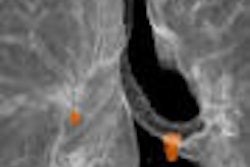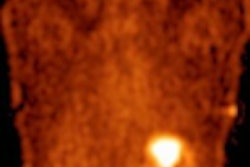TORONTO - PET scanning with a rubidium-82 radiopharmaceutical can be a cheaper and less invasive alternative to cardiac catheterization in patients who have a nondiagnostic SPECT study, according to research presented Monday at the Society of Nuclear Medicine (SNM) meeting.
SPECT is a workhorse cardiac imaging modality, but some 10% to 20% of ECG-gated myocardial perfusion scans cannot be classified as normal or abnormal for various reasons, such as with significant photon attenuation when imaging obese patients. These patients are usually sent on for coronary angiography.
Could PET give physicians a way to avoid cardiac cath when SPECT is equivocal? Researchers at St. Luke's Hospital in Kansas City, MO, wanted to find out, according to Dr. Darcy Green Conaway, who presented the research.
The group conducted 11,632 SPECT studies between September 2001 and March 2003. Of these, 233 patients had nondiagnostic studies and were referred for a rubidium-82-based PET study using an Excel PET camera (CTI Molecular Imaging, now Siemens Medical Solutions, Malvern, PA).
The average age of the population was 62 years ± 12, 149 were female (64%), and they had a mean body mass index of 31.7 kg/m2. Patients were followed for a mean of 675 days ± 343 days. Some 20% of the patients were diabetics and 20% had histories of known coronary artery disease, such as past bypass surgery or percutaneous coronary intervention. The group found no difference in the percentage of nondiagnostic SPECT studies as measured by the type of radiotracer used (thallium, technetium sestamibi, or dual isotopes).
PET was able to resolve 98% of the nondiagnostic SPECT studies, reclassifying patients as either normal or abnormal, according to Conaway. There were five nondiagnostic PET studies, which occurred due to either incorrectable misregistration, poor counts or excessive noise, or severe patient motion.
Of this group, PET scans were normal in 170 patients (73%), and only 58 patients (25%) were reclassified as abnormal. Only three patients in the normal group went on to have coronary angiography within 60 days of PET (none of whom turned out to have significant coronary disease). Of the 58 abnormal patients, 29 were referred to coronary angiography within 60 days of PET and 18 had revascularization. Of the 29 patients who received angiography, 20 had significant coronary disease.
Conaway's group also calculated the cost-savings that PET offers in being able to divert normal patients from receiving coronary angiography studies. The average cost of a PET study is about $1,480 (including Medicare patient and co-pay rates and technical and professional fees), compared to $3,270 for a cardiac cath.
By extrapolating these costs to the study's 233-person population, Conaway said that sending all the patients to cardiac cath would have cost a total of $762,000. But by using PET instead after nondiagnostic SPECT, the cost would only be $528,000, even if 25% of the abnormal patients also went on to receive coronary angiography.
"Rubidium-82 myocardial perfusion PET is both useful and prognostically predictive in a heterogeneous patient population with challenging SPECT scans," Conaway said. "PET following nondiagnostic SPECT resolved all of our patients except five, and these findings did influence the coronary arteriogram rates. The majority of these patients had a normal PET and were associated with a low likelihood of short-term events, obviating unnecessary coronary angiography."
By Brian Casey
AuntMinnie.com staff writer
June 21, 2005
Related Reading
Imaging tackles cardiac 'octopus pot' syndrome, April 19, 2005
PET medicare reimbursement -- narrow but widening, June 17, 2004
Copyright © 2005 AuntMinnie.com




















